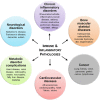The expanding role of immunopharmacology: IUPHAR Review 16
- PMID: 26173913
- PMCID: PMC4556463
- DOI: 10.1111/bph.13219
The expanding role of immunopharmacology: IUPHAR Review 16
Abstract
Drugs targeting the immune system such as corticosteroids, antihistamines and immunosuppressants have been widely exploited in the treatment of inflammatory, allergic and autoimmune disorders during the second half of the 20th century. The recent advances in immunopharmacological research have made available new classes of clinically relevant drugs. These comprise protein kinase inhibitors and biologics, such as monoclonal antibodies, that selectively modulate the immune response not only in cancer and autoimmunity but also in a number of other human pathologies. Likewise, more effective vaccines utilizing novel antigens and adjuvants are valuable tools for the prevention of transmissible infectious diseases and for allergen-specific immunotherapy. Consequently, immunopharmacology is presently considered as one of the expanding fields of pharmacology. Immunopharmacology addresses the selective regulation of immune responses and aims to uncover and exploit beneficial therapeutic options for typical and non-typical immune system-driven unmet clinical needs. While in the near future a number of new agents will be introduced, improving the effectiveness and safety of those currently in use is imperative for all researchers and clinicians working in the fields of immunology, pharmacology and drug discovery. The newly formed ImmuPhar (http://iuphar.us/index.php/sections-subcoms/immunopharmacology) is the Immunopharmacology Section of the International Union of Basic and Clinical Pharmacology (IUPHAR, http://iuphar.us/). ImmuPhar provides a unique international expert-lead platform that aims to dissect and promote the growing understanding of immune (patho)physiology. Moreover, it challenges the identification and validation of drug targets and lead candidates for the treatment of many forms of debilitating disorders, including, among others, cancer, allergies, autoimmune and metabolic diseases.
© 2015 The British Pharmacological Society.
Figures




References
Publication types
MeSH terms
Substances
Grants and funding
LinkOut - more resources
Full Text Sources
Other Literature Sources

